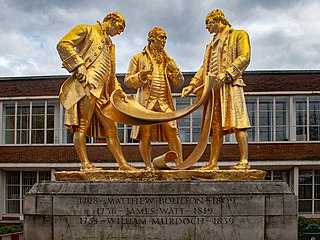
James Watt was a Scottish inventor, mechanical engineer, and chemist who improved on Thomas Newcomen's 1712 Newcomen steam engine with his Watt steam engine in 1776, which was fundamental to the changes brought by the Industrial Revolution in both his native Great Britain and the rest of the world.
The year 1787 in science and technology involved some significant events.
The year 1782 in science and technology included many events, some of which are listed here.

Alexander Cumming FRSE was a Scottish watchmaker and instrument inventor, who was the first to patent a design of the flush toilet in 1775, which had been pioneered by Sir John Harington, but without solving the problem of foul smells. As well as improving the flush mechanism, Cummings included an S-trap to retain water permanently within the waste pipe, thus preventing sewer gases from entering buildings. Most modern flush toilets still include a similar trap.
The year 1830 in science and technology involved some significant events, listed below.
The year 1773 in science and technology involved some significant events.
The year 1892 in science and technology involved some significant events, listed below.
The year 1816 in science and technology involved some significant events, listed below.

The year 1897 in science and technology involved some significant events, listed below.
The year 1861 in science and technology involved some significant events, listed below.
The year 1854 in science and technology involved some significant events, listed below.

The year 1843 in science and technology involved some significant events, listed below.
The year 1784 in science and technology involved some significant events.
The year 1774 in science and technology involved some significant events.

Boulton & Watt was an early British engineering and manufacturing firm in the business of designing and making marine and stationary steam engines. Founded in the English West Midlands around Birmingham in 1775 as a partnership between the English manufacturer Matthew Boulton and the Scottish engineer James Watt, the firm had a major role in the Industrial Revolution and grew to be a major producer of steam engines in the 19th century.
Steam power developed slowly over a period of several hundred years, progressing through expensive and fairly limited devices in the early 17th century, to useful pumps for mining in 1700, and then to Watt's improved steam engine designs in the late 18th century. It is these later designs, introduced just when the need for practical power was growing due to the Industrial Revolution, that truly made steam power commonplace.

Joseph Bramah was an English inventor and locksmith. He is best known for having improved the flush toilet and inventing the hydraulic press. Along with William Armstrong, 1st Baron Armstrong, he can be considered one of the two fathers of hydraulic engineering.
Events from the year 1774 in Great Britain.
James Watt junior, FRS was an English engineer, businessman and activist.

The Stanhope Demonstrator was the first machine to solve problems in logic. It was designed by Charles Stanhope, 3rd Earl Stanhope to demonstrate consequences in logic symbolically.







